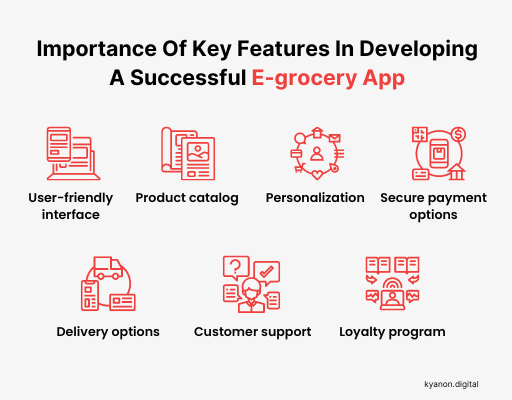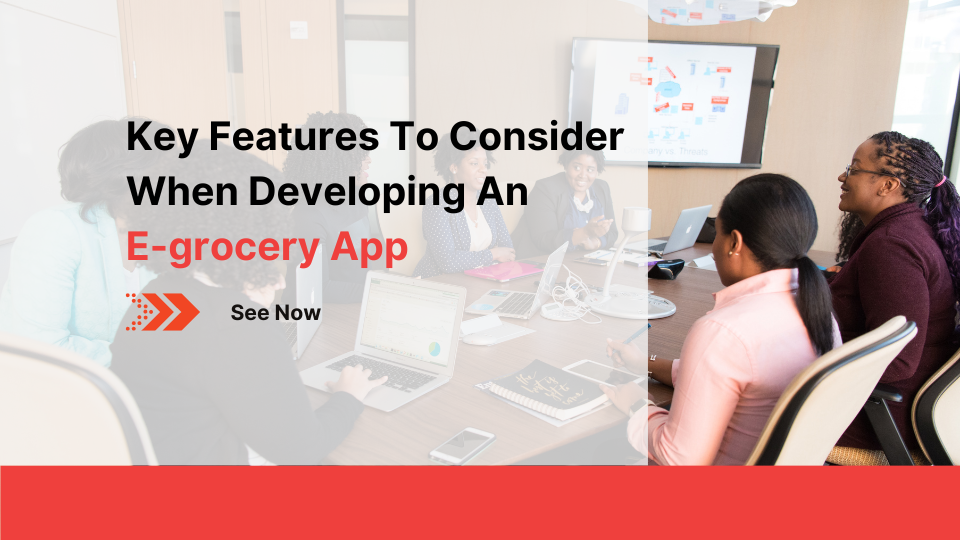E-grocery apps are mobile applications that allow customers to shop for groceries and household essentials online, from the convenience of their smartphones or tablets. These apps typically offer a wide range of products, including fresh produce, meat, dairy, pantry staples, and personal care items, and they provide customers with a seamless shopping experience that allows them to easily browse and select items, add them to their virtual cart, and check out with a variety of payment options.
The popularity of e-grocery apps has increased significantly in recent years, due in part to the COVID-19 pandemic and the shift towards online shopping. With more people staying at home and avoiding crowded stores, e-grocery apps have become an attractive option for those looking to minimize their exposure to the virus while still getting the groceries they need.
Other factors contributing to the popularity of e-grocery apps include their convenience, speed, and accessibility. Customers can shop for groceries anytime, anywhere, and have them delivered straight to their doorstep, often within a few hours. E-grocery apps also offer a variety of promotions, discounts, and loyalty programs that can help customers save money on their purchases. In this article, we will walk you through some key features to consider when developing an e-grocery app.

1. Benefits of e-grocery apps
E-grocery apps are online platforms that allow customers to purchase groceries and other household items from the convenience of their homes. These apps benefit businesses in several ways, including increased reach, increased sales, cost savings, customer insights, and competitive advantage.
E-grocery app benefits can come from reaching a wider audience and increasing sales by providing a seamless and convenient shopping experience. They can also save on costs related to physical stores, streamline their operations, and gain valuable insights into customer behavior and preferences. Furthermore, e-grocery apps can provide businesses with a competitive advantage by offering unique features and differentiating themselves from competitors. Overall, e-grocery apps are a valuable tool for businesses looking to increase their online presence and reach more customers.

2. Importance of key features in developing a successful e-grocery app
Developing a successful e-grocery app requires careful consideration of several key features that are essential to creating a positive user experience and meeting the needs of your customers. Here are some important features that should be included in any e-grocery app:

2.1 User-friendly interface
A user-friendly interface is a crucial component of any successful e-grocery app. It refers to the design and layout of the app’s interface, which should be intuitive, easy-to-use, and visually appealing. A well-designed interface can make the difference between a successful app that customers love to use and a frustrating app that customers quickly abandon.
To create a user-friendly interface, businesses should focus on elements such as simple navigation, consistency in design, responsive design, visual hierarchy, and minimalism. These elements can help guide users through the app, draw their attention to important elements, and make the app easy and enjoyable to use.
Overall, a user-friendly interface is essential for increasing customer engagement and loyalty, driving more sales, and ultimately creating a successful e-grocery app.

2.2 Product catalog
The product catalog is a critical aspect of any e-grocery app. It is used to describe the database or collection of all the products that are available for purchase through the app. The product catalog is essentially the online equivalent of a physical store’s product shelves or aisles.
The product catalog in an e-grocery app should be well-organized and easy to navigate, with clear categories, subcategories, and filters that allow users to quickly find the products they need. The product catalog should also include detailed product descriptions, images, and prices to help users make informed purchasing decisions.
In order to create an effective product catalog in an e-grocery app, businesses should focus on elements such as accurate and up-to-date product information, high-quality images, and a search function that allows users to easily find specific products. Additionally, businesses should consider offering personalized product recommendations based on users’ past purchases or browsing behavior to increase engagement and customer loyalty.
Generally, a well-designed and well-curated product catalog is essential for creating a successful e-grocery app that offers a seamless and convenient shopping experience for customers.

2.3 Personalization
Personalization in e-grocery apps relates to the ability to tailor the shopping experience to individual users based on their past purchases, browsing behavior, and preferences. This can be achieved through various techniques such as product recommendations, personalized offers and discounts, customized shopping lists, and personalized notifications.
Personalization can help businesses increase customer engagement, loyalty, and ultimately drive more sales. By analyzing a user’s data, businesses can offer relevant and personalized recommendations, promotions, and notifications that are tailored to the user’s interests and needs.
In general, personalization is a powerful tool for businesses to create a more convenient, enjoyable, and rewarding shopping experience for their customers. By providing a personalized shopping experience, businesses can increase customer satisfaction and loyalty, which can lead to increased sales and revenue.

2.4 Secure payment options
Secure payment options are a crucial section of any e-grocery app. Customers need to trust that their personal and financial information is being handled securely and that their transactions are protected against fraud.
To ensure secure payment options in e-grocery apps, businesses should provide multiple payment methods that are widely accepted, such as credit cards, debit cards, and digital wallets. They should also use secure payment gateways that encrypt customers’ financial information during the transaction process and protect against fraudulent activities.
Additionally, businesses should comply with industry standards and regulations for data protection and privacy, such as the Payment Card Industry Data Security Standard (PCI DSS) and General Data Protection Regulation (GDPR).
By providing secure payment options, businesses can increase customer trust and confidence, which can lead to increased sales and revenue. Customers are more likely to return to an e-grocery app that they trust and feel secure using for their online shopping needs.

2.5 Delivery options
Delivery options are a vital part of any e-grocery app. They are associated with the various methods by which customers can receive their orders, such as home delivery, curbside pickup, or in-store pickup.
To offer effective delivery options in e-grocery apps, businesses should provide multiple delivery methods that cater to different customer needs and preferences. For example, customers may prefer to have their groceries delivered to their doorstep, while others may prefer to pick up their orders themselves.
Businesses should also offer flexible delivery options, such as same-day or next-day delivery, to cater to customers’ needs for convenience and urgency. Additionally, businesses should consider offering real-time tracking and notifications to keep customers informed about the status of their orders.
To ensure efficient delivery options in e-grocery apps, businesses should also optimize their delivery routes and schedules to minimize delivery times and costs.
Therefore, providing effective and convenient delivery options in e-grocery apps can help businesses increase customer satisfaction and loyalty, leading to increased sales and revenue. By catering to customers’ diverse needs and preferences, businesses can provide a seamless and convenient shopping experience that encourages customers to return for future purchases.

2.6 Customer support
Customer support is an important component of any e-grocery app. It focuses on the various methods by which customers can receive assistance and support when they encounter issues with the app or their orders. To offer effective customer support in e-grocery apps, businesses should provide multiple support channels, such as email, phone, chat, or in-app messaging. They should also ensure that their customer support team is well-trained, knowledgeable, and responsive to customers’ needs.
Additionally, businesses should consider offering self-service options, such as FAQs or chatbots, to help customers quickly resolve common issues without needing to contact customer support. To ensure efficient and effective customer support in e-grocery apps, businesses should also track customer feedback and complaints to identify recurring issues and improve their service accordingly.
As a whole, providing effective customer support in e-grocery apps can help businesses increase customer satisfaction and loyalty, leading to increased sales and revenue. By offering responsive and helpful customer support, businesses can build trust and confidence with their customers, which can encourage them to return for future purchases.

2.7 Loyalty program
In e-grocery apps, a loyalty program implies a system that rewards customers for making purchases or engaging with the app in other ways. To offer an effective loyalty program in e-grocery apps, businesses should provide rewards that are relevant and valuable to their customers. This can include discounts, free items, exclusive promotions, or other benefits that encourage customers to continue shopping with the app.
Businesses should also consider using gamification techniques, such as points, levels, or badges, to incentivize customers to engage more frequently with the app and earn more rewards. To ensure the success of a loyalty program in e-grocery apps, businesses should also track and analyze customer behavior to identify patterns and preferences that can inform their rewards and promotions.
Overall, a loyalty program in e-grocery apps can help businesses increase customer retention and loyalty, leading to increased sales and revenue. By rewarding customers for their loyalty, businesses can build a stronger relationship with their customers and create a sense of community around their brand.

3. Conclusion
When developing an e-grocery app, it’s essential to consider features that enhance the user experience and make shopping for groceries online convenient and efficient. A user-friendly interface, product catalog, payment and delivery options, can further streamline the shopping process. Additionally, including loyalty programs, personalized recommendations, and customer support can help retain customers and provide a positive shopping experience.

Building an e-grocery app requires careful planning, research, and execution. By following these steps, you can develop an app that addresses the needs of your target audience and provides them with a seamless and convenient shopping experience. Kyanon Digital hopes this article brings you useful information of key features to consider when developing an e-grocery app. Contact us and have consultation with our experts to build an e-grocery app for your businesses.


